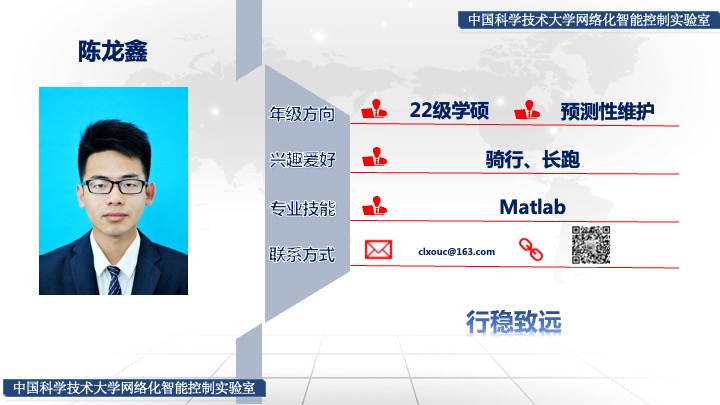个人信息

参与实验室科研项目
人机智能协同关键技术及其在智能制造中的应用
非可信智能驱动的可靠智造
研究课题
SMT生产过程数据驱动的PCBA元件焊接缺陷自动复检方法研究
学术成果
共撰写/参与撰写专利 3 项,录用/发表论文 2 篇,投出待录用论文0篇。
patent
-
锡膏印刷质量异常预测方法、系统、设备及存储介质
赵云波,
刘斌琨,
康宇,
曹洋,
陈龙鑫,
and 李佳玉
2025
[pdf]
-
锡膏印刷机在线故障预测软件V1.0
赵云波,
陈龙鑫,
朱慧娟,
康宇,
and 许镇义
2022
[Abs]
[pdf]
本软件系统用于锡膏印刷机的在线故障预测,通过 url 接口实时获取锡膏印刷机 的状态数据,调用事先训练好的机器学习模型进行故障预测,并将故障预测结果 展示在前端可视化界面,以辅助工程师及时进行维护。
-
故障诊断模型的训练方法、装置、电子设备及存储介质
赵云波,
陈龙鑫,
刘斌琨,
朱慧娟,
许镇义,
and 柏鹏
[Abs]
本申请公开了一种故障诊断模型的训练方 法、装置、电子设备及存储介质,属于计算机技术 领域。所述方法包括:获取多个工况中各工况集 下的故障数据,分别作为源域数据,并获取目标 工况下的故障数据,作为目标域数据,所述工况 集包括所述多个工况中的至少一个工况,所述工 况集下的故障数据为已标记故障类别的数据,所 述目标工况下的故障数据为未标记故障类别的 数据;确定所述目标域数据与各所述源域数据之 间的目标分布差异;根据所述目标分布差异选取 源域数据作为训练数据;根据所述训练数据,对 所述目标工况的故障诊断模型进行训练。本申请 能够提高模型训练效果,进而提高对目标工况进 行故障诊断的准确率。
Conference Articles
-
A Reliable Ensemble Model Based on Hierarchical Component Features for Repair Label Prediction of Soldering Defects
Longxin Chen,
Yunbo Zhao,
Binkun Liu,
Shaojie Dong,
Huijuan Zhu,
and Peng Bai
In 2024 14th Asian Control Conference (ASCC)
2024
[Abs]
[pdf]
Using solder paste inspection (SPI) and automated optical inspection (AOI) data, accurate prediction for repair labels of soldering defective printed circuit board (PCB) components can help reduce labor costs. Existing research tries to pick out both the false defect components (actually good) and impossible-to-repair components among defective PCB components, using SPI and AOI data. However, it is inappropriate to pick out the false defect components from screened components using defective information in AOI data. Therefore, the problem setting of existing research is inappropriate, resulting in the algorithm’s performance not meeting actual requirements. To address this problem, we only care about the reliable prediction of impossible-to-repair components. We propose a hierarchical component feature extraction method that can comprehensively characterize the degree of component defects from multiple levels, including pin level and component level. Then we apply the ensemble model based on XGBoost and TabNet and adjust the probability threshold of components judged as impossible-to-repair category, achieving the reliable prediction of impossible-to-repair components. Finally, we validated our method on real datasets and achieved better experimental results compared to baseline methods, which can meet actual requirements,
-
Prediction of Yield in Functional Testing of Motherboards in Laptop Manufacturing
Yunbo Zhao,
Shaojie Dong,
Yu Kang,
Kangcheng Wang,
Longxin Chen,
and Peng Bai
In 2024 14th Asian Control Conference (ASCC)
2024
[Abs]
[pdf]
Functional testing stands as a pivotal quality control step in the production process of laptop motherboards, aiming to validate the proper functioning of various components. However, due to the multitude of functional modules involved on the motherboard, testing all of them requires a significant amount of time and resources. As a result, production line engineers often rely on empirical selection of modules with low yield rates for testing. However, such empirical yield estimation is often inaccurate. To address this challenge, this study proposes a hybrid model based on XGBoost and Long Short-Term Memory (LSTM) networks to predict the yield of each functional module. By harnessing the feature learning capability of XGBoost and the sequential modeling power of LSTM, this model efficiently explores the intricate correlations among motherboard functional modules, thereby accurately forecasting their yields. We extensively train and validate the model using historical production data and successfully deploy it on real laptop motherboard production lines. Experimental results demonstrate that our hybrid model accurately predicts the yield of each functional module, providing crucial guidance for the functional testing process. Through in-depth analysis of the predicted yield results, engineers can systematically choose testing projects to save time and resources. This research offers a novel approach and pathway for enhancing motherboard production efficiency and quality.
博客文章
学位论文
Theses
-
PCB缺陷元件复检及其可修复性判定方法研究
陈龙鑫
中国科学技术大学, 合肥
2025
[Abs]
[pdf]
表面贴装技术(Surface Mount Technology, SMT)是一种将电子元件焊接到 印刷电路板(Printed Circuit Board, PCB)表面指定位置的技术。为把控焊接质量, 标准 SMT 工艺采用自动光学检测(Automated Optical Inspection, AOI)机器对完 成焊接的 PCB 元件进行初步缺陷检测。然而,据调研,超过 95% 的 AOI 初检缺 陷元件实际并无缺陷。因此,需由专人对 AOI 初检缺陷元件进行缺陷复检,并 对复检为缺陷的元件进行可修复性判定。这两个环节高度依赖人工,会耗费较大 人力成本,影响生产效率。因此,实现自动的缺陷元件复检及其可修复性判定, 可以节省人力成本,并提高产线的自动化水平及生产效率。 但是,在实现自动的缺陷元件复检及其可修复性判定的过程中,面临以下难 点:在缺陷元件自动复检任务中,复检无缺陷元件的数量远超复检缺陷元件的数 量,存在数据类别高度不平衡的难点;在缺陷元件可修复性自动判定任务中,复 检缺陷元件的数量少,存在数据样本量小的难点。目前相关研究较少,尚处于初 步探索阶段,未充分关注并深入解决上述难点,因此取得的效果有限。 因此,本文基于 SMT 生产过程数据,针对缺陷元件自动复检任务和缺陷元 件可修复性自动判定任务展开研究。
毕业去向
比亚迪股份有限公司, 软件工程师

